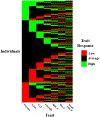Regular exercise and patterns of response across multiple cardiometabolic traits: the HERITAGE family study
- PMID: 33619128
- PMCID: PMC8380259
- DOI: 10.1136/bjsports-2020-103323
Regular exercise and patterns of response across multiple cardiometabolic traits: the HERITAGE family study
Abstract
Objectives: We investigated whether high responsiveness or low responsiveness to exercise training aggregates in the same individuals across seven cardiometabolic traits.
Methods: A total of 564 adults (29.2% black, 53.7% female) from the HERITAGE family study completed a 20-week endurance training programme (at 55%-75% of participants' maximal oxygen uptake (VO2max)) with VO2max, per cent body fat, visceral adipose tissue, fasting levels of insulin, high-density lipoprotein cholesterol, small low-density lipoprotein particles and inflammatory marker GlycA measured before and after training. For each exercise response trait, we created ethnicity-specific, sex-specific and generation-specific quintiles. High responses were defined as those within the 20th percentile representing the favourable end of the response trait distribution, low responses were defined as the 20th percentile from the least favourable end, and the remaining were labelled as average responses.
Results: Only one individual had universally high or low responses for all seven cardiometabolic traits. Almost half (49%) of the cohort had at least one high response and one low response across the seven traits. About 24% had at least one high response but no low responses, 24% had one or more low responses but no high responses, and 2.5% had average responses across all traits.
Conclusions: Interindividual variation in exercise responses was evident in all the traits we investigated, and responsiveness did not aggregate consistently in the same individuals. While adherence to an exercise prescription is known to produce health benefits, targeted risk factors may not improve.
Keywords: exercise physiology; exercise training.
© Author(s) (or their employer(s)) 2022. No commercial re-use. See rights and permissions. Published by BMJ.
Conflict of interest statement
Competing interests: None declared.
Figures

Similar articles
-
Association of Dimethylguanidino Valeric Acid With Partial Resistance to Metabolic Health Benefits of Regular Exercise.JAMA Cardiol. 2019 Jul 1;4(7):636-643. doi: 10.1001/jamacardio.2019.1573. JAMA Cardiol. 2019. PMID: 31166569 Free PMC article. Clinical Trial.
-
Effects of endurance exercise training on plasma HDL cholesterol levels depend on levels of triglycerides: evidence from men of the Health, Risk Factors, Exercise Training and Genetics (HERITAGE) Family Study.Arterioscler Thromb Vasc Biol. 2001 Jul;21(7):1226-32. doi: 10.1161/hq0701.092137. Arterioscler Thromb Vasc Biol. 2001. PMID: 11451756 Clinical Trial.
-
High-density lipoprotein-cholesterol, its subfractions, and responses to exercise training are dependent on endothelial lipase genotype.Metabolism. 2003 Nov;52(11):1505-11. doi: 10.1016/s0026-0495(03)00284-1. Metabolism. 2003. PMID: 14624415 Clinical Trial.
-
Individual differences in response to regular physical activity.Med Sci Sports Exerc. 2001 Jun;33(6 Suppl):S446-51; discussion S452-3. doi: 10.1097/00005768-200106001-00013. Med Sci Sports Exerc. 2001. PMID: 11427769 Review.
-
Meta-Analyses of the Effects of Habitual Running on Indices of Health in Physically Inactive Adults.Sports Med. 2015 Oct;45(10):1455-68. doi: 10.1007/s40279-015-0359-y. Sports Med. 2015. PMID: 26178328 Free PMC article. Review.
Cited by
-
Multiomics Approach to Precision Sports Nutrition: Limits, Challenges, and Possibilities.Front Nutr. 2021 Dec 14;8:796360. doi: 10.3389/fnut.2021.796360. eCollection 2021. Front Nutr. 2021. PMID: 34970584 Free PMC article. Review.
-
Metabolic Predictors of Cardiorespiratory Fitness Responsiveness to Continuous Endurance and High-Intensity Interval Training Programs: The TIMES Study-A Randomized Controlled Trial.Metabolites. 2024 Sep 23;14(9):512. doi: 10.3390/metabo14090512. Metabolites. 2024. PMID: 39330519 Free PMC article.
-
Metabolomic Response throughout 16 Weeks of Combined Aerobic and Resistance Exercise Training in Older Women with Metabolic Syndrome.Metabolites. 2022 Oct 30;12(11):1041. doi: 10.3390/metabo12111041. Metabolites. 2022. PMID: 36355124 Free PMC article.
-
Review of Exercise Interventions to Improve Clinical Outcomes in Nondialysis CKD.Kidney Int Rep. 2024 Aug 2;9(11):3097-3115. doi: 10.1016/j.ekir.2024.07.032. eCollection 2024 Nov. Kidney Int Rep. 2024. PMID: 39534200 Free PMC article. Review.
-
Aerobic and resistance exercise-regulated phosphoproteome and acetylproteome modifications in human skeletal muscle.Nat Commun. 2025 Jul 1;16(1):5700. doi: 10.1038/s41467-025-60049-0. Nat Commun. 2025. PMID: 40595512 Free PMC article. Clinical Trial.
References
-
- Physical Activity Guidelines Advisory Committee. Physical activity guidelines Advisory Committee scientific report, 2018.
-
- Bouchard C, Rankinen T. Individual differences in response to regular physical activity. Med Sci Sports Exerc 2001;33:S446–51. - PubMed
-
- Hautala AJ, Kiviniemi AM, Mäkikallio TH, et al. Individual differences in the responses to endurance and resistance training. Eur J Appl Physiol 2006;96:535–42. - PubMed
MeSH terms
Substances
Grants and funding
LinkOut - more resources
Full Text Sources
Other Literature Sources
Medical
